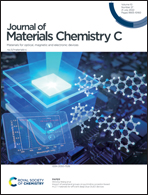Perylene diimide derivative dispersed in LDH as a new efficient red-emitting phosphor for LED applications†
Abstract
Perylene diimide-based dyes substituted by four sulfonate groups at their bay position are known to be extremely sensitive to their mutual π–π intermolecular interaction. They do not emit fluorescence in solid state. When co-hosted in LDH with a surfactant in extremely small quantities, an absolute photoluminescence quantum yield (PL QYabs) of about 35% is reached upon blue excitation at 465 nm for a dye content as low as 0.1% of the total interleaved anions and yet revealing the presence of excimers. When this material is dispersed in silicone, the emission spectrum exhibits a blue shift compared to the hybrid assembly. A saturated red color with PL QYabs as high as 50% is obtained. When this red-emitting film is combined with a YAG/Ce silicone film and a blue LED chip emitting at 465 nm, warm white light (T = 3366 K) with a high color rendering index of 91.4 is produced. Finally, the phosphors hosted in LDH are photo-stable even when dispersed in a silicone matrix, with emission properties that do not suffer any decrease in intensity under combined thermal and photonic stresses, thus opening up real possibilities for applications in LED technology.



 Please wait while we load your content...
Please wait while we load your content...